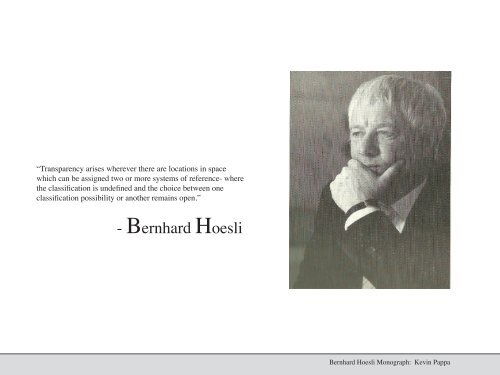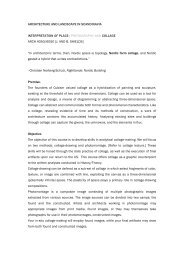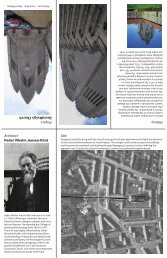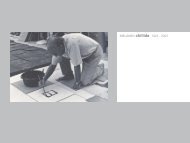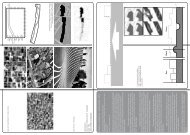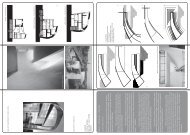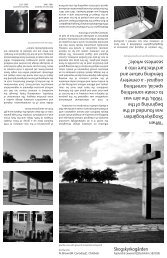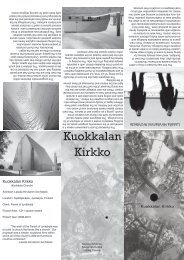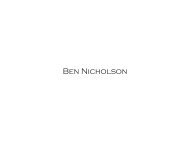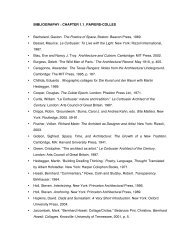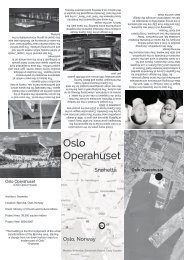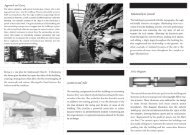- Bernhard Hoesli - collage and architecture
- Bernhard Hoesli - collage and architecture
- Bernhard Hoesli - collage and architecture
Create successful ePaper yourself
Turn your PDF publications into a flip-book with our unique Google optimized e-Paper software.
“Transparency arises wherever there are locations in space<br />
which can be assigned two or more systems of reference- where<br />
the classification is undefined <strong>and</strong> the choice between one<br />
classification possibility or another remains open.”<br />
- <strong>Bernhard</strong> <strong>Hoesli</strong><br />
<strong>Bernhard</strong> <strong>Hoesli</strong> Monograph: Kevin Pappa
F. LEGER “The Gray Root” c.1953<br />
B. HOESLI “No. 13” c.1964<br />
Formation of Pedagogy<br />
<strong>Bernhard</strong> <strong>Hoesli</strong> was born on January 13th, in 1923 in<br />
Zurich, Switzerl<strong>and</strong> to parents that owned a road construction<br />
company. After earning a degree in <strong>architecture</strong> from ETH he<br />
began working at Le Corbusier’s studio in Paris <strong>and</strong> Marsaille.<br />
While in Paris he studied painting under Fern<strong>and</strong> Leger who is<br />
largely responsible for the development of the Section d’Or, or<br />
Golden Section. Leger’s mentorship left evidence in some of<br />
<strong>Hoesli</strong>’s earlier <strong>collage</strong> works like No.13. Here similarities arise<br />
in the balance between the shallow <strong>and</strong> deep space. Through a<br />
diagrammatic lens both compositions are arrangements of figures,<br />
relatively in the same plane, in front of a secondary field. Both<br />
also have a major <strong>and</strong> minor grain, which begins to speak to the<br />
overlapping nature present in so many of <strong>Hoesli</strong>’s <strong>collage</strong>s.<br />
<strong>Bernhard</strong> <strong>Hoesli</strong> Monograph: Kevin Pappa<br />
<strong>Bernhard</strong> <strong>Hoesli</strong> Monograph: Kevin Pappa
In 1951, he began his influential career in education<br />
by becoming a professor at the School of Architecture at the<br />
University of Texas at Austin. Alongside Colin Rowe <strong>and</strong> Robert<br />
Slutzky, the Texas Rangers changed the face of architectural<br />
education in the United States <strong>and</strong> Switzerl<strong>and</strong>. Rowe <strong>and</strong><br />
Slutzky’s definition of transparency laid groundwork for <strong>Hoesli</strong>’s<br />
teaching curriculum based on the use of precedents. At Texas a<br />
major pedagogical goal was identifying <strong>and</strong> teaching the language<br />
of Modern Architecture, <strong>and</strong> cubism was a key to that language.<br />
The normal precise wash renderings at the Ecole de Beaux Arts<br />
led to an <strong>architecture</strong> lacking in rigor. He began to rationalize<br />
<strong>and</strong> propagate the works of Cezanne <strong>and</strong> other cubists as a new<br />
language for demonstrating that rigor. Flattened, angular, <strong>and</strong><br />
spatial abstractions of the space-mass continuum led to more<br />
justifiable compositions. <strong>Hoesli</strong> believed that cubism’s synthesize<br />
of figure <strong>and</strong> field rather than its fracture was the requisite<br />
characteristic of Modern Architecture.<br />
In 1956 the director of the School of Architecture at UT<br />
resigned causing a fallout of many of the Texas Rangers. <strong>Hoesli</strong><br />
returned to Switzerl<strong>and</strong> <strong>and</strong> began teaching the first year courses<br />
at the ETH in Zurich. From 1959 until 1981 he directed the first<br />
year design program – the Grundkurs – at the ETH. <strong>Hoesli</strong>’s<br />
pedagogical revolution became part of the permanent structure of<br />
the curriculum as he involved himself in practically all aspects of<br />
the <strong>architecture</strong> program. At the same time, he ran a Zurich firm<br />
with Werner Aebli between 1960 <strong>and</strong> 1970 while also serving as<br />
Chairman of the Architecture Department of the ETH. In 1972, he<br />
barely survived nearly fatal injuries from a car accident until his<br />
unexpected death in 1984. He was 61 years old.<br />
<strong>Bernhard</strong> <strong>Hoesli</strong> Monograph: Kevin Pappa
Collage Methodology<br />
His early <strong>collage</strong> work suggests that they were some<br />
form of retreat from <strong>and</strong> perhaps an opposition to the hardedged<br />
abstractions of modern <strong>architecture</strong>. It can be seen<br />
as his personal way of exploring the manipulation of space<br />
through the eyes of both the architect <strong>and</strong> the painter.<br />
However, a greater architectural overtone comprised of figure<br />
– field relationships exists. Compositions are organized by<br />
subtle overlappings, feathering of edges, <strong>and</strong> ambiguous depth<br />
cues. Often it is difficult to tell which planar elements advance<br />
<strong>and</strong> which recede.<br />
<strong>Hoesli</strong> also implements an assortment of materials in<br />
the <strong>collage</strong>s. References to Papier Colle are best exemplified<br />
through torn <strong>and</strong> cut fragments of paper along with graphic<br />
clippings from periodicals. Layers of throwaway materials<br />
like cardboard, blocks of discarded wood, <strong>and</strong> common<br />
household materials prevent any notions of high art. A bias<br />
towards the avante-garde Art Informal style at the time is<br />
clarified by his incorporation of plain <strong>and</strong> otherwise useless<br />
materials. These haptic materials speak to the significance of<br />
chance <strong>and</strong> time in his design process. It is important to note<br />
<strong>Hoesli</strong>’s classification of a successful <strong>collage</strong>.<br />
<strong>Bernhard</strong> <strong>Hoesli</strong> Monograph: Kevin Pappa
“So a <strong>collage</strong> is not only meant as an object,<br />
something made, a result, but what is perhaps far more<br />
interesting: a process. Moreover, that behind this way<br />
of doing something which as a result then leads to a<br />
<strong>collage</strong>, the <strong>collage</strong> could be meant as an attitude of<br />
mind…”<br />
<strong>Hoesli</strong>’s works are literally <strong>and</strong> figuratively layered<br />
to reveal their material composition <strong>and</strong> methods of<br />
fabrication. Surface materials are often exposed as<br />
defined shapes trapped between other layers in the<br />
composition. This creates a reversal of figure <strong>and</strong><br />
ground. Interrupted complex grids <strong>and</strong> patterns,<br />
thick built up materials, <strong>and</strong> textures set against sharp<br />
disharmonies <strong>and</strong> discontinuities eventually become<br />
synonyms to what he found challenging <strong>and</strong> generative<br />
in architectural design.<br />
<strong>Bernhard</strong> <strong>Hoesli</strong> Monograph: Kevin Pappa
Collage & Architecture<br />
For example, No. 2 is composed of a cluster of wood<br />
blocks that overlap two base levels, one raised, <strong>and</strong> a<br />
lower contoured beach-like level. At first glance, one<br />
may mistake this for an architectural model. Instead,<br />
the composition is juxtaposed against an alternative<br />
shallow sculptural relief. Paper covers multiple<br />
connections between masses which masques discrete<br />
building-like volumes. Wood grain of certain surfaces<br />
is not present, further denying the fact that they are<br />
architectural elements. The contrast between a shallow<br />
relief <strong>and</strong> architectural model sets up a dialogue<br />
between two-dimensional <strong>and</strong> three-dimensional<br />
space or a play of phenomenal transparency. The<br />
quiet monumentality present in several of his <strong>collage</strong>s<br />
corresponds to his <strong>architecture</strong>. In the case of the<br />
Reynolds House, rectilinear <strong>and</strong> angles shapes respond<br />
to the site while the material palette dramaticizes the<br />
dialogue between earth <strong>and</strong> sky.<br />
<strong>Bernhard</strong> <strong>Hoesli</strong> Monograph: Kevin Pappa
In <strong>collage</strong> No. 26 a scaled hierarchy of differentiated<br />
elements begins to imply the plan of a Catholic Church<br />
in Glattbrugg, Switzerl<strong>and</strong>. Here <strong>Hoesli</strong> features the<br />
pre-existing temporal qualities of the site. An old<br />
bell tower along the street for example, like a found<br />
object in <strong>collage</strong>, is integrated by means of a diagonal<br />
alignment with the church.<br />
<strong>Bernhard</strong> <strong>Hoesli</strong> Monograph: Kevin Pappa
Le Corbusier’s void-solid reversal painting is an<br />
impressive example of the spatial clamping together of<br />
external <strong>and</strong> internal - the mass-space continuum. This<br />
overall relationship can be applied to works like Villa<br />
Currutchet in La Plata, Argentina. Here interior <strong>and</strong><br />
exterior spaces have sectional dialogues similar to Le<br />
Corbusier’s painting.<br />
<strong>Bernhard</strong> <strong>Hoesli</strong> Monograph: Kevin Pappa
Interpretation<br />
At the foundation of <strong>Hoesli</strong>’s work was the concept of temporality.<br />
His <strong>collage</strong>s were only momentarily completed, not finished or<br />
inviolable works. He frequently revisited the <strong>collage</strong>s at later dates,<br />
sometimes up to 15 years, <strong>and</strong> would pursue new ideas not stressed<br />
in the previously ‘completed’ <strong>collage</strong>. These ideas may be lingering<br />
in his mind or on the back of many of his works. Personal sketch<br />
fragments, comments, <strong>and</strong> dates were haphazardly arranged for future<br />
reference. On a concrete retaining wall leading to the garage at his<br />
house, he intermittently worked for many years on an ongoing outdoor<br />
<strong>collage</strong>. Exchanges between <strong>Hoesli</strong>, v<strong>and</strong>als, <strong>and</strong> the weather has<br />
unfortunately left no physical or photographic record. Confrontations<br />
between disparate elements <strong>and</strong> the return to old work encompass his<br />
underlying idea of impermanence. <strong>Hoesli</strong>’s unique style of updating<br />
keeps alive disturbing but productive questions <strong>and</strong> doubts. Who<br />
knows what came first – the unanswered question or the <strong>collage</strong>s?<br />
“I am impatient…with the interminable insistence on the undeniable<br />
perceptual differences between the buildings by F.L. Wright, Le<br />
Corbusier, <strong>and</strong> Mies.”<br />
<strong>Bernhard</strong> <strong>Hoesli</strong> Monograph: Kevin Pappa
<strong>Hoesli</strong>’s <strong>collage</strong>s were personal explorations that<br />
reveal a lot about his way of seeing <strong>and</strong> working.<br />
They brought up challenges interpreted as testing<br />
grounds for the design process he implemented<br />
in teaching. <strong>Hoesli</strong>’s commentary in the<br />
seminal Transparency essay is more concise <strong>and</strong><br />
applicable than Rowe <strong>and</strong> Slutzky’s overly specific<br />
comparisons. For <strong>Hoesli</strong>, “this was a matter of<br />
implied as opposed to literal visual continuities<br />
<strong>and</strong> overlaps, <strong>and</strong> the perception of deep space<br />
constantly opposed to the implication of shallow<br />
space.” Transparency allows us to see structures<br />
through a lens independent of the differences<br />
between historical <strong>and</strong> modern – a tool for the<br />
production of complex systems of order during the<br />
design process.<br />
“Collage was not the celebration of our victory over<br />
modernity. It was living out the true promise of<br />
modernity as something both existentially fateful<br />
<strong>and</strong> socially cohesive.”<br />
<strong>Bernhard</strong> <strong>Hoesli</strong> Monograph: Kevin Pappa


